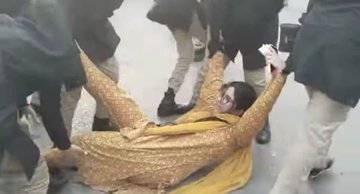On Sunday, October 13, 2024, the streets outside the Karachi Press Club turned into a battlefield where brutality reigned and cries for justice were silenced under the crushing force of police batons. It was meant to be a peaceful protest, a simple demand for justice—a plea for accountability in the extrajudicial killing of Dr. Shahnawaz Kanbhar, a man whose only crime was being wrongfully accused of blasphemy. But instead of the justice they sought, the protesters faced a torrent of violence, a stark reminder of the growing intolerance in Sindh and the deafening silence of those in power.
The protest was a desperate call to end religious extremism in a province long plagued by fear and oppression. Dr. Shahnawaz’s death was a tragedy that exposed the fragile and flawed systems governing blasphemy accusations. The Sindh Human Rights Commission had already pointed out the fatal mistakes in the registration of his case, and even Home Minister Zia Ul Hassan Lanjar admitted that Dr. Shahnawaz had been wrongfully killed in a staged police encounter. Yet, the murderers walk free. The clerics who spewed hate and issued the fatwa that marked him for death are untouched by the hands of justice, while some have even secured bail before their arrest.
The horrors didn’t stop with Dr. Shahnawaz’s death. In Umerkot, the flames of hatred were fanned even further. Extremists held rallies, their voices filled with venom as they incited violence, threatening the Hindu community and those brave enough to speak against the injustice. The government, it seemed, had no response. No arrests were made. No action was taken. Their silence was deafening, their inaction a cruel joke.
Meanwhile, in Karachi, the Sindh Rawadari March gathered under the shadow of Section 144, their peaceful rally met with barricades, plainclothes officers, and containers blocking every path to their destination. The tension in the air was palpable, as activists, poets, authors, and progressive voices from all corners of Sindh assembled to honor the memory of Dr. Shahnawaz and demand a better future for their province.
Among the protesters was Dr. Sorath Sindhu, standing alongside her sister, Meeran. She knew the risks, but she could not remain silent. “Why are you arresting us?” she questioned, her voice strong despite the looming threat. “Our only crime is being Sindhi and speaking out against injustice.” Her defiance was met with force as police officers, disregarding their laws, hauled her and her sister away. The protest had barely begun, and already the police were crushing it beneath their heels.
Despite this, the crowd pushed on. They chanted for justice, peace, and the rights of Sindh. But as they reached the gates of the Karachi Press Club, the true force of the state came down on them. The police, unchecked and unrelenting, descended upon the marchers with batons swinging. Shirts were torn, protesters were dragged by their hair, and the air was thick with the screams of the beaten and the broken.
The violence didn’t spare anyone. Authors like Jami Chandio, poets like Saif Samajo, and activists like Roomasa Jami faced the full wrath of the police. Roomasa watched helplessly as her father, Jami, was torn from her side, his body brutalized by the very people meant to protect him. Her cries of “Baba, Baba, Baba,” echoed through the chaos, but they fell on deaf ears. There was no mercy that day, no respect for the dignity of those who had come only to speak their truth.
At the gate of the Karachi Press Club, what should have been a sanctuary for free speech became a site of torment. Even journalists, tasked with recording these events, found themselves under attack. Cameras were seized, roads were blocked, and the police, encouraged by their unchecked power, laughed as they broke their batons over the bodies of the defenseless. One officer even mocked the protesters, urging his colleagues to be more violent.
By the end of the day, the bloodied and bruised protesters were released, but the damage had been done. The police had filed charges against them, twisting the narrative and turning the victims into criminals. The hypocrisy was staggering—while the government condemned the violence in public, their police forces were busy filing charges against those very same peaceful marchers.
As the dust settled and the wounds began to heal, one thing became clear: Sindh is burning. And in the heart of that fire are people who refuse to give up, who will continue to fight for justice, even as the world around them falls apart. But for how long can they hold out? How long before the weight of oppression crushes them completely? The answers remain uncertain, but the struggle continues, with hope flickering like a dying flame in the wind.
